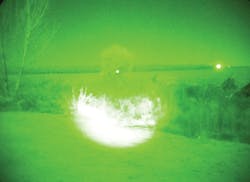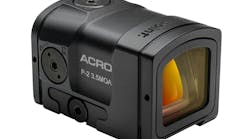When Laser Devices Inc. (LDI) debuted their class on IR lasers at the 2011 SHOT Show, I knew this company was turning a new corner in meeting its customer’s demands. This year they did not disappoint with several new products in the class one line. The one that excited me the most was the new DBAL-D2 (Dual Beam Aiming Laser – D2). The DBAL-D2 is a truly revolutionary development in the infrared/night vision world.
What makes the DBAL-D2 so special is the replacement of the left hand IR laser used as an illuminator, as seen on the DBAL-A2 and PEQ-15, with a powerful LED IR flashlight. Having used a military spec DBAL-A2 for several years, I have always found the laser-generated IR illuminator lacking. The amount of usable light was too tightly focused. This made the illuminator almost useless in tight confines such as houses, commercial buildings and alleyways. I’m not saying that open terrain, forests and orchards are not part of a law officers beat; I only wish to point out that illuminating the exterior of a building 500 meters away with IR light with a DBAL-A2 has not been one of those things that I have needed to do compared with being able to see down a staircase, or lighting up a room or the interior of a vehicle.
For several years military, law enforcement and civilians who use night vision regularly have been employing IR filters on white lights or IR flashlights, such as the Surefire line of Vampire lights, to provide IR light for close or short range IR illumination. This has required the operator to add a second light to their weapon, make their white light dual purpose. Neither are optimal as they add more weight, time delays and can lead to confusion when the operator needs a white light and has to “convert” their light from IR to white light. The best solution has always been an IR illuminator built into the IR laser that is capable of illuminating a room as well as a hill or tree line several hundred yards away that activates in conjunction with the IR aiming laser. The folks at Laser Devices have solved this issue with the DBAL-D2’s LED IR illuminator.
The illuminator consists of four IR LED lights housed in a focusable housing. The focus lens is like a camera lens in that the variable bezel allows the operator to focus the IR light from a wide short range 30-degree beam to a narrow long range 2-degree beam. The illuminator has a high (600mW) and low (300mW) stetting, allowing the operator to select the best application of light given their needs. Using the illuminator was very simple and I was able to get the settings to where I needed them very quickly. Being right-handed, I simply used my left hand to reach forward and adjust the bezel and power settings when mounted on my M4 carbine. The left side of the D2 is larger than that found on other LDI models. This is due to the larger LED illuminator.
The right side of the DBAL-D2 is the same as the DBAL-A2 and other DBAL models offered by Laser Devices. It houses a red or green visible aiming laser as well as a Class one 0.7mW eye-safe IR aiming laser. The visible and IR aiming lasers are slaved together so that once you sight in the visible laser the IR laser is sighted in as well. The adjustment controls are recessed and protected from bumps and damage. The unit can be activated by a button at the rear of the left side of the unit, remote pressure pad, or a constant ‘On’ setting via the activation mode selector switch at the rear of the unit. The activation mode selector switch is used to select between visible laser, IR laser and IR illuminator, as well as high and low settings. I found that by moving the activation button from the top of the unit, like on the DBAL-A2 and –I2 models, to the rear of the left side of the unit was a great idea.
It was very simple for me to reach up with my left thumb and activate the unit. For those who do not like to use remote pressure pads you’re really going to like this, unless of course you’re left-handed. The only issue I had with this location was with gloved hands. Sometimes under stress it was a bit difficult to feel the center of the button. I suggested to LDI engineers they add a small raised ring around the button to aid in locating it with gloved hands. It appears that this ring was added to the current production models, along with the ability to add a short section of rail on top of the unit to allow for the installation of a small red dot optic.
The housing is made from very strong machined aluminum just like all of LDI’s military laser units. When you examine the unit you realize it was made to survive a beating and keep working. Some who assisted in testing it used the term “built like a tank”. I had to concur that this is an excellent way to describe the feel of the unit; it is a solid piece of kit. The D2 attaches to weapon mounted rails with the outstanding HT Self-Adjusting Throw-Lever, which is now standard on every LDI laser. I have grown to hold this mount in high regard for its durability and dependability.
I mounted the D2 on my M4 carbine and took it to the field. The IR illuminator worked great inside of buildings, around commercial equipment yards and in orchards. In open areas like fields and our foothills it performed beautifully. It gave more than enough illumination to identify cars and old farm equipment from the landscape. LDI has a photo on their web page showing the D2 illuminating a hill 800 meters away. This is consistent with my testing when using a three power magnifier on my PVS-14. To take full advantage of the D2 illuminator you’re going to need to add some magnification to your night vision device. LDI says that the IR aiming laser is visible out to about 250 yards. During testing, on a night with a full moon, I could see the IR aiming laser out past 400 yards against an Almond orchard.
But let’s put this performance into perspective. The maximum distance that most Gen3 night vision devices can provide positive identification of what you’re shooting at is just over 100 yards. You can see objects and persons past this, but making positive ID gets much harder. The range of the 0.7mW Class one IR laser is more than adequate and gives you the added benefit of eye safety. If you already have a Class III IR laser in inventory do this for a quick test of performance: the low setting on the Military DBAL-A2 is 0.7mW, the same as the D2 and other LDI Class one IR lasers. Use the Class III on low and you can test the capability of the Class one line.
If you recall my past article about the LDI Class one lasers (July 2011 issue of LET), the first generation was produced with a 0.07mW laser. Last summer LDI discovered they could push the laser to 0.7mW and still be eye-safe. This is why they have such a longer range now. LDI offers an upgrade for those with the older units. I took advantage of this upgrade for both of my first production run models of the OTAL and DBAL-I2. The difference in range is significant and worth the inconvenience of sending them in.
I did find some drawbacks. When you have the illuminator on high inside of structures, or directed against anything that can reflect the IR light back at you, the IR aiming laser can get washed out and lost. For close range use the lower setting to avoid this. I tended to use the low setting the vast majority of the time. The size of the illuminator on the wide setting was not as wide as I would have liked. I was testing the LDI OV-3 IR and white light flashlight at the same time as the D2 and found the throw and corona of the IR illuminator on the OV-3 preferable to that of the D2 for my needs. Due to the power needed, the D2 is only available in a CR123 battery version. I like the versatility of the AA battery versions of the A2, A3 and I2 lasers in the LDI DBAL line-up. Unfortunately current technology does not allow for that option. The biggest drawback is the “downrange signature” that is inherent to all LED IR lights. The can produce a red visible light that can be seen out to 100 yards or more when looking directly at the LED. It is a very narrow “sweet spot” where the light can be seen, but is a concern for some. During testing it was not as big of a concern as I had anticipated. As such, proper light discipline and awareness of the issue must be implemented when using this unit, or any LED IR illuminator.
Now some things will be changing on the production versions of the D2 compared to the prototype I tested. I knew that the unit I was provided for testing was one of the first made. What I did not know until I returned it is that it is one of the first 10 prototypes made. Since this initial run of prototypes changes have been made to the housing, lightening up the unit, as well as changes to some of the materials used. LDI has been listening to its end users and adjusting the final product as improvements have been identified. One interesting antidote that I found personally interesting is that the tan units of the D2 will have black controls and other accents, just like the custom unit LDI made for me last year. From my experience this is a good idea as the controls are easily located due to the contrast.
LDI keeps listening to its customers and delivering innovative products to meet those needs. The DBAL-D2 was originally dreamed up by pig hunters in Texas. LDI quickly realized its commercial and Government sales potential and have brought, what I feel, is the next step in IR aiming technology.
The DBAL-D2 is currently available in black or tan with black contrasts. Units are available from retailers with a cost around $1,500 to $1,800 depending on options.



